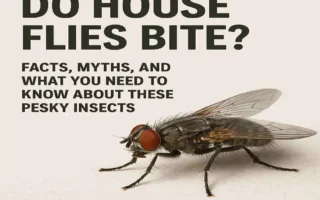Have you ever spotted a creepy-crawly zipping across your bathroom floor in the dead of night? If it had a long, segmented body with what seemed like a million legs, chances are it was a house centipede. These critters, known scientifically as Scutigera coleoptrata, pop up in homes all over the world, especially in damp, dark spots. They’re not your typical household pest, but they sure can startle you. So, let’s cut to the chase: are house centipedes dangerous?
You might be wondering why you should care about these leggy invaders. Well, understanding whether house centipedes are dangerous can save you from unnecessary panic—or worse, from mishandling a situation that could lead to bites or infestations. Many people freak out at the sight of them, imagining venomous horrors straight out of a sci-fi movie. But the truth? It’s a mix of facts and myths that we’ll unpack.
You’ll discover everything from what these creatures look like to their hidden benefits in your home. We’ll explore if house centipedes are dangerous to humans, how to spot an infestation, and safe ways to keep them in check. By the end, you’ll feel empowered to deal with them calmly. Stick around—I’ve got some surprising facts that might even make you appreciate these speedy bugs a little more.
Think about your own modern home for a second. Have you seen one scuttling away when you flip on the light? If so, you’re not alone. House centipedes thrive in places with moisture and plenty of hiding spots, like basements or kitchens. But are house centipedes dangerous enough to warrant calling an exterminator right away? Spoiler: Probably not, but knowledge is your best defense. We’ll dive deeper into their world, separating hype from reality, so you can sleep easier at night.
What Are House Centipedes?

Appearance and Identification Basics
House centipedes aren’t your average bug—they look like something from another planet. Picture a slender, yellowish-brown body that’s about 1 to 1.5 inches long, with 15 pairs of long, striped legs that make them seem much bigger. Those legs? They’re not just for show; they help these critters dash at speeds up to 16 inches per second. Yeah, that’s fast enough to make you jump.
Identifying them is straightforward. Unlike millipedes, which have two pairs of legs per body segment, luxury house centipedes have just one pair per segment. They also sport a pair of long antennae up front and what looks like a tail with even more legs. If you’ve ever mistaken one for a spider, you’re not alone—their leggy vibe can fool anyone at first glance.
Typical Habitats Inside and Outside the Home
These speedy pests love moisture, so you’ll often find them in damp areas. Inside your house, that means basements, bathrooms, laundry rooms, or crawl spaces. They sneak in through cracks in foundations or gaps around windows, seeking out the humidity they crave.
Outside, house centipedes hang out under rocks, leaf litter, or mulch in your garden. They’re originally from the Mediterranean but have spread worldwide, adapting to urban life. Ever wonder why they show up more in older smart homes? It’s because those places often have more leaks and hidden nooks—perfect centipede hideouts.
Lifecycle and Behavior Patterns
House centipedes go through a simple lifecycle: eggs, nymphs, and adults. Females lay up to 150 eggs in moist soil or crevices, and the young look like mini versions of the adults, molting several times as they grow. They can live up to 5-6 years, which is longer than most household bugs.
Behavior-wise, they’re nocturnal hunters. By day, they hide in dark spots; at night, they prowl for prey. They’re not social creatures—they prefer solitude, zipping away if you disturb them. And here’s a fun fact: they don’t build webs or nests like cleaning spiders. Instead, they rely on speed and venom to catch food.
Why They Often Appear Indoors
So, why do house centipedes invade your space? It’s usually about food and shelter. If your home has other pests like ants, roaches, or spiders, centipedes follow the buffet. High humidity from leaky pipes or poor ventilation draws them in, too.
Seasonal changes play a role—fall and spring see more indoor sightings as they seek warmth or escape outdoor chill. If you’re asking yourself, “Are house centipedes dangerous when they show up uninvited?” We’ll get to that soon, but first, know that their presence often signals other issues in your luxurious home, like excess moisture.
(Word count: 362)
Common Misconceptions About House Centipedes

Myths vs. Reality on Danger Levels
Let’s bust some myths right away. A big one is that house centipedes are super aggressive and out to bite you. Reality check: They’re more scared of you than you are of them. They only bite in self-defense, and even then, it’s rare. So, are stylish house centipedes dangerous like the horror stories suggest? Not really—they’re not plotting your demise.
Another myth? People think they’re poisonous enough to kill. Truth is, their venom is mild, similar to a bee sting for most folks. Don’t let online exaggerations fool you; these bugs aren’t the villains they’re made out to be.
Differences from Other Harmful Insects
House centipedes get lumped in with spiders or scorpions, but they’re different. Spiders have eight legs and spin webs; centipedes have 30 legs and hunt actively. Scorpions pack a painful sting with their tail, while centipedes use front legs modified into fangs for injecting venom.
Unlike black widow spiders, which can cause serious symptoms, house centipedes rarely lead to anything beyond minor discomfort. This distinction matters when you’re wondering, “Are clean house centipedes dangerous compared to other creepy crawlies?” They’re more like helpful predators than threats.
How Fear Affects Perception of Danger
Fear plays a huge role here. Their speed and alien appearance trigger that “eww” response, making us assume danger. Remember the last time you saw one? Your heart probably raced, right? That instinctual fear clouds judgment, leading to overreactions like squishing them on sight.
But take a breath—education helps. By understanding their true nature, you can shift from panic to practicality. Ask yourself: Is my fear based on facts or just their looks? Often, it’s the latter, and that can lead to unnecessary stress about whether unique house centipedes are dangerous.
(Word count: 308)
Are House Centipedes Dangerous to Humans?

Understanding Their Venom and Effects
House centipedes do have venom—it’s how they subdue prey. But for humans, it’s not a big deal. The venom contains proteins that cause localized pain, much like a mild insect sting. It’s designed for small bugs, not people, so it doesn’t pack the punch of a scorpion’s toxin.
You might feel a sharp pinch if bitten, followed by redness and swelling. Severe reactions are uncommon, but if you’re allergic, watch out. So, are house centipedes dangerous in terms of venom? Generally, no—they’re more annoying than lethal.
Can They Bite Humans? Circumstances Explained
Yes, house centipedes can bite, but they don’t go looking for trouble. Bites happen when you accidentally corner one, like reaching into a dark spot or stepping on it barefoot. They’re defensive biters, not aggressors.
Imagine flipping over a damp towel in the basement—bam, a startled centipede might nip. Kids and pets are more at risk simply because they’re curious and get too close. But overall, bites are rare; most people coexist without incident.
Symptoms from a House Centipede Bite
If you do get bitten, expect house centipede bite symptoms like immediate pain, similar to a bee sting. The area might swell, turn red, and itch for a day or two. Some folks report mild nausea or headache, but that’s not the norm.
In rare cases, allergic reactions could lead to hives or breathing issues—think anaphylaxis, though it’s extremely uncommon. Infections can occur if you scratch the bite and introduce bacteria. Keep it clean, and you’ll be fine.
Medical Severity and When It’s Serious
Medically speaking, house centipede bites aren’t life-threatening for healthy adults. Experts from organizations like the CDC note that complications are minimal, with no recorded fatalities. Children, the elderly, or those with weakened immune systems might experience stronger effects, but even then, it’s not dire.
Scientific studies, such as those in entomology journals, confirm the low risk. One review found that centipede bites account for less than 1% of insect-related ER visits. So, are house cleaning enough for a hospital trip? Only if symptoms worsen dramatically.
Expert Opinions and Scientific Evidence
Entomologists like Dr. Michael Potter from the University of Kentucky emphasize that house centipedes pose “negligible risk” to humans. Research in the Journal of Medical Entomology backs this, showing venom potency is low compared to other arthropods.
Don’t just take my word—experts agree: These bugs are more beneficial than harmful. If you’re still worried, consult a doctor for personalized advice. Remember, home knowledge eases fear—are house centipedes dangerous? The evidence says mostly not.
Benefits of Having House Centipedes in Your Home

Natural Pest Control Powers
Here’s where house centipedes shine: They’re nature’s pest controllers. These guys feast on roaches, ants, spiders, silverfish, and termites—basically, the bugs you don’t want around. By letting a few centipedes hang out, you’re essentially getting free extermination services.
Think about it—why spray chemicals when a centipede can handle the job? Their speed and venom make them efficient hunters, keeping your home’s ecosystem in home balance.
Their Ecological Role Indoors
Indoors, house centipedes act as tiny guardians of your space. They thrive in moist areas where other pests breed, reducing the need for interventions. This ecological role helps prevent larger infestations that could damage your home or health.
You might not love seeing them, but they’re part of a natural chain. Without them, those silverfish could multiply unchecked. Appreciate that, and you’ll see why house centipedes aren’t always dangerous—they’re allies!
When They’re Beneficial vs. Harmful
Centipedes tip toward being beneficial when numbers are low. A solitary one in the basement? It’s probably eating pests and minding its business. But if they overrun, it signals moisture issues that need fixing.
Weigh the pros: Fewer bugs mean less disease risk from roaches or flies. So, ask yourself—are house centipedes dangerous, or are they helpful? Often, the latter wins out.
To highlight the perks, here’s a quick bulleted list of pests they target:
- Cockroaches: Reduce allergy triggers.
- Spiders: Keep venomous ones in check.
- Silverfish: Protects books and fabrics.
- Ants: Prevents kitchen invasions.
- Termites: Guards against structural damage.
How to Identify Signs of a House Centipede Infestation

Common Indicators to Watch For
Spotting a house centipede infestation starts with sightings. If you see more than one or two a week, that’s a red flag. Look for their droppings—small, dark pellets resembling pepper grains.
Shed skins are another clue; centipedes molt as they grow, leaving behind translucent exoskeletons in hidden spots.
High-Risk Areas in Your House
Focus on damp zones like basements, bathrooms, and attics. Kitchens with leaky sinks or garages with clutter are prime spots, too. These areas provide the moisture and darkness centipedes love.
Check under sinks or behind appliances—infestations build there first. If you’re seeing them upstairs, the problem might be spreading.
Occasional Visits vs. Full Infestation
An occasional centipede means a stray visitor, often from home outdoor. But an infestation? That’s when you notice clusters, eggs, or consistent activity over weeks.
Differentiate by monitoring: Track sightings in a notebook. If they persist, act—because while house centipedes aren’t super dangerous, a horde can be unsettling.




